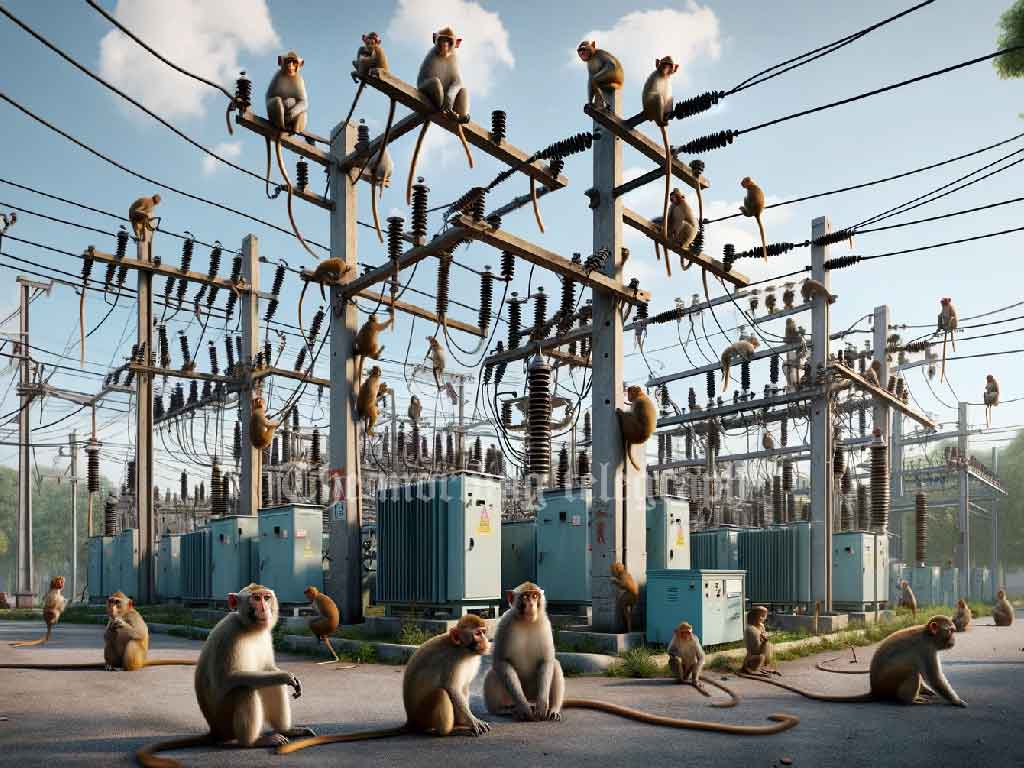
Power outages are typically attributed to system failures, severe weather, or human errors. However, in a handful of bizarre incidents, single animals have managed to bring entire nations to a standstill by triggering catastrophic blackouts.
Here are three of the most astonishing cases where an animal, through an unfortunate (or mischievous) act, plunged an entire country into darkness.
1. Sri Lanka’s Nationwide Blackout – The Monkey That Sparked Chaos (2025)
Sri Lanka faced an unprecedented nationwide power outage in February 2025, leaving the entire island without electricity for several hours. The culprit? A monkey.
According to Power Minister Jayakodi, the animal had interfered with the Panadura Grid Substation, triggering a massive disruption in the national electricity network. The Ceylon Electricity Board (CEB) immediately launched restoration efforts, but due to the cascading impact of the fault, certain areas remained in darkness for an extended period.
The Ministry of Power and Energy, however, later described the incident as an “emergency at the Panadura substation” without directly confirming the monkey’s involvement. This contradiction sparked speculation, with some questioning whether an animal alone could be responsible for such a large-scale failure or if deeper systemic issues within the country’s power grid were to blame. Regardless of the exact cause, the incident served as a stark reminder of Sri Lanka’s fragile infrastructure where due to one small disruption the entire country was thrown into chaos.
2. Zambia’s Electrical Nightmare – Monkey Mayhem (2016)
In Zambia, a monkey was blamed for causing an extensive blackout that affected nearly half the country in 2016. The animal managed to tamper with a circuit breaker at the Kafue Gorge Power Station, a major hydroelectric facility.
ZESCO, the country’s main electricity provider, confirmed that the monkey had somehow accessed critical equipment, leading to a system overload. While power was restored later that day, the event sparked discussions about security measures around vital national infrastructure.
Zambia, like many African nations, faces frequent power disruptions due to maintenance challenges, but having an entire country thrown into darkness because of a single monkey was a new low. The incident raised questions about the vulnerability of essential services to animal interference, with many suggesting improved fencing and deterrent measures.
3. Kenya’s Vervet Monkey Disaster – A Nationwide Blackout (2016)
Just months before Zambia’s incident, Kenya suffered a nationwide blackout in an eerily similar manner. The culprit this time? A vervet monkey.
The mischievous primate climbed onto a transformer at the Gitaru Hydroelectric Power Station, one of Kenya’s most crucial energy hubs. In doing so, it triggered a system-wide failure, cutting off electricity to millions.
The Kenya Electricity Generating Company (KenGen) reported that the monkey had fallen onto high-voltage equipment, causing an overload that tripped the entire national grid. Miraculously, the monkey survived the incident and was later handed over to the Kenya Wildlife Service.
Following this bizarre event, KenGen assured the public that they would implement additional security measures at power stations to prevent similar occurrences. However, the incident quickly became a source of both embarrassment and amusement, highlighting vulnerabilities in Kenya’s power infrastructure.
More Animal-Induced Power Disruptions Around the World
While Sri Lanka, Zambia, and Kenya hold the unfortunate record of experiencing full-scale national blackouts caused by animals, several other countries have also suffered significant disruptions due to nature’s tiny troublemakers:
4. New Zealand’s Possum Problem (2015)
- A possum in New Zealand caused a major blackout affecting 50,000 homes after it climbed onto a substation in North Island and triggered a short circuit.
5. Squirrels: America’s Biggest Electrical Threat
- Squirrels have been responsible for more power outages in the United States than cyberattacks.
- In 1987, a squirrel knocked out power to 40,000 people in California.
- In 2015, a single squirrel disrupted operations at a Nissan car plant in Tennessee.
- In 2016, a squirrel took down power at the Arkansas State Capitol.
6. Japan’s Bird-Induced Blackout (2018)
- A crow in Tokyo caused a widespread power outage by dropping a piece of wire into a substation, leading to a major short circuit.
7. Canada’s Beavers Chewing Through Power Lines (2019)
- In British Columbia, Canada, a beaver chewed through a fiber-optic cable, leaving thousands of residents without power and internet.
When Nature Meets Infrastructure
These incidents highlight how a single animal can expose the vulnerabilities of modern electrical grids. Whether it’s a monkey in Sri Lanka, a squirrel in the US, or a beaver in Canada, it’s clear that even the most advanced power networks can be disrupted by an unexpected visitor from the wild.
As amusing as these stories may be, they also serve as a wake-up call for utility companies worldwide to improve safeguards and strengthen critical infrastructure before the next mischievous animal strikes again!





These explanations of Sri Lanka’s latest, Kenya’s and Zambia’s country wide power grid failure defy plausibility.
The other examples from New Zealand, America, Canada and Japan are much more believable given that the alleged third party (animal) involvement only affected a portion of the grid.
Taking Sri Lanka’s latest misfortune, the explannation of a single substation event leading to nationwide grid failure, suggests that the set-up and operation of the grid is seriously deficient. Such single location events should not in a well managed grid system lead to complete grid failure.
It suggests to me that the explanation is a smokescreen for a wider failure of grid operational systems and staff on the day.
It’s time the Electrical Engineering mafia running Sri Lanka’s energy systems were held to account.